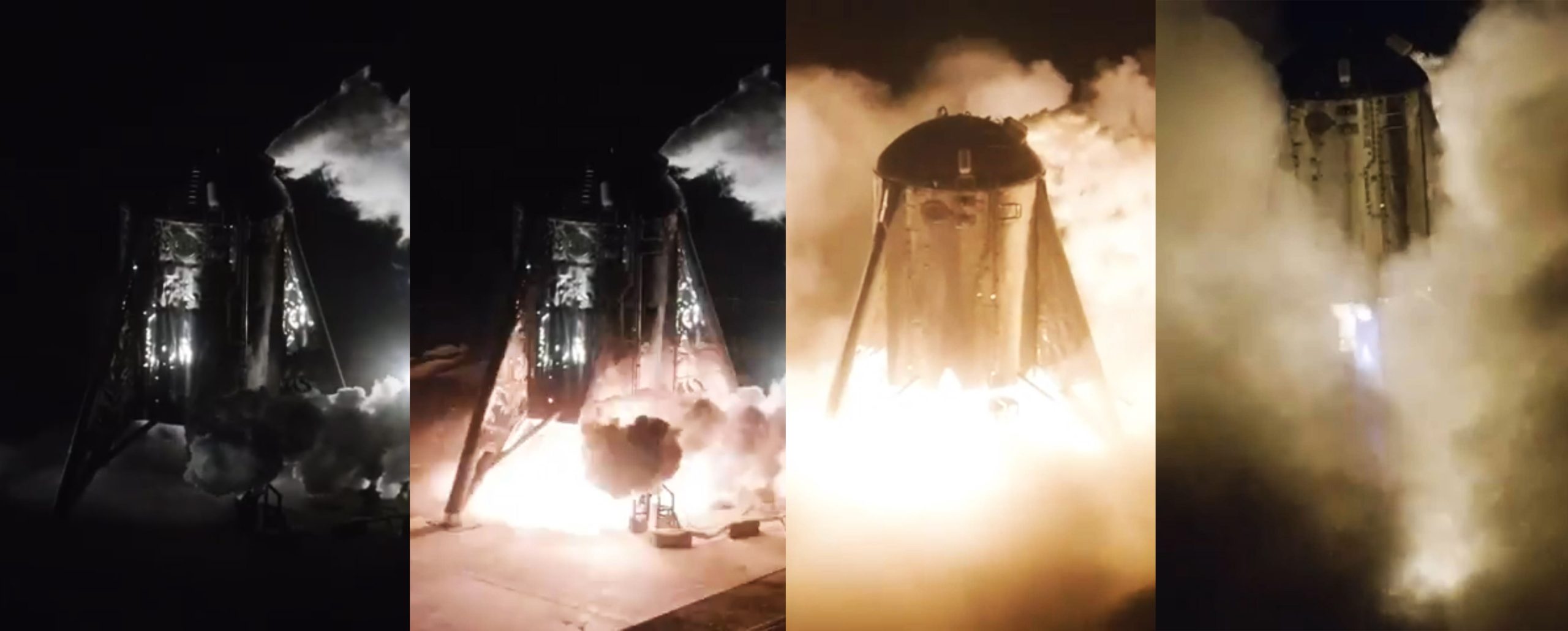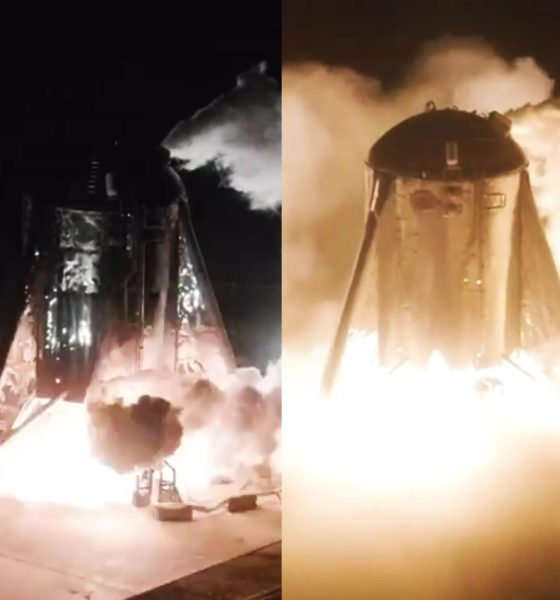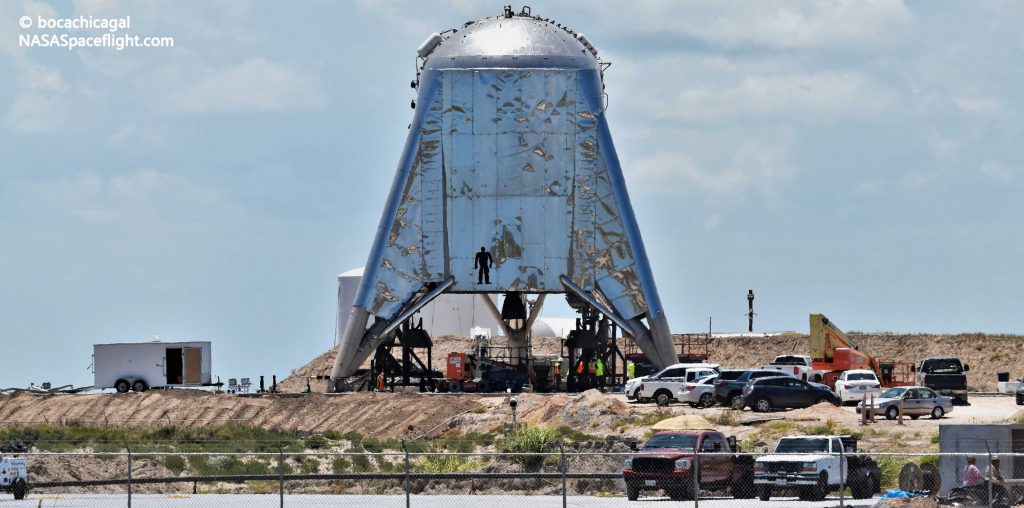

News
SpaceX’s Starhopper cleared by FAA for second and final flight test as locals urged to exit homes
After a full two weeks spent waiting for an FAA permit, SpaceX CEO Elon Musk and local South Texas authorities appear to be preparing Starhopper for a second major flight test as early as Monday, August 26th.
Assuming the FAA comes through with a permit, Starhopper is scheduled to lift off no earlier than 5pm EDT (21:00 UTC) on August 26th for a flight test expected to smash the low-fidelity Starship prototype’s previously altitude record of ~20m (65 ft). Confirming initial reports from NASASpaceflight.com, Musk also stated that Starhopper’s second flight will be its last, after which the steel rocket test-bed will be converted for stationary use at SpaceX’s South Texas facilities.
Prior to Musk tweeting that Starhopper may be nearing approval for its next flight, the SpaceX CEO revealed that delays were centered around the FAA’s apparent unwillingness to permit the vehicle’s next flight. Musk specifically stated that the FAA wanted more “hazard analysis”, meaning that the US aviation administration had concerns that Starhopper could pose a serious threat to local residents in a tiny housing development known as Boca Chica Village.
Technically speaking, Boca Chica Village is just 1.5 miles (2.4 km) away from SpaceX’s Starhopper launch facilities, where the vehicle is expected to reach a maximum altitude of no more than 200m (650 ft) as early as August 26th. FAA regulations tend to be prescriptive and extremely rigid, understandable given the breadth of US aviation-related activities the agency is tasked with regulating. However, a basic back-of-the-envelope analysis of Starhopper’s 200m hop suggests that the risk to local residents – even those as few as 1.5 miles away from the test – is minuscule.
Based on Starhopper’s inaugural flight, its lone Raptor engine – producing up to 200 tons (450,000 lbf) of thrust – is not exactly capable of rapidly moving the Starship prototype. For all accounts and purposes, Starhopper is a spectacularly heavy hunk of steel with the aerodynamics of a cylindrical brick – capable of flight solely through the brute-force application of a literal rocket engine. To make it even half of the distance from its launch site to the Village, Starhopper would have to remain in controlled flight while radically deviating from its planned trajectory, all while its flight termination system (FTS) – explosives meant to destroy the vehicle in a worst-case scenario – completely fails to activate.

As evidence of the apparent lack of perceived risk to local residents, Cameron County, Texas officials distributed flyers to Village residents advising – but not requiring – those choosing to remain at their homes during the test to go outside during Starhopper’s next flight. This is recommended to avoid flying glass in the event that the vehicle explodes, potentially shattering windows with the shockwave that could result, but clearly demonstrates the fact that county officials believe there is a near-zero chance of Starhopper actually impacting anywhere near the houses.
Ultimately, Starhopper’s limited flight tests clearly pose little to no actual risk to residents, but this chapter does raise a far more significant question: what happens once Starship Mk1 is ready and the flight tests SpaceX is pursuing involve distances and heights on the order of several, tens, or hundreds of kilometers? For now, answers will have to wait til a later date.
A Hop and a skip into retirement
Aside from the delays and apparent lack of consensus on the safety of Starhopper’s minor hop tests, Musk confirmed that the prototype’s second test flight ever will likely be its last, providing some interesting insight into SpaceX’s next steps. Most notably, the fact that SpaceX is willing and ready to fully retire Starhopper after such a limited test series serves as a fairly confident statement that orbital-class Starship Mk1 (Texas) and Mk2 (Florida) prototypes are extremely close to flight-readiness.
Roughly a month ago, Musk tweeted that those Starship prototypes could be ready for their first flights as early as mid-September to mid-October, “2 to 3 months” from mid-July. In additional comments made on August 20th, Musk stated that his planned Starship presentation would be delayed in light of Starhopper’s own delays, and is now instead expected to occur around a major Starship Mk1 integration milestone in “mid September”.
As previously discussed on Teslarati, Starhopper’s brief service life is entirely unsurprising, delayed by issues with Raptor engines to the point that SpaceX’s far more valuable Starship prototypes – having made relentless progress – are already nearing completion. Once those Starships are ready for almost any kind of integrated testing, Starhopper will be made entirely and immediately redundant.
“According to Musk, either or both of those orbital-class prototypes could be ready for their inaugural flight tests as early as mid-September, perhaps just 1-2 months from now. Given that Starships Mk1 and Mk2 are significantly higher fidelity than Starhopper, the ungainly testbed will likely become redundant the moment that its successors are ready for flight. In other words, Starhopper is fast approaching the end of its useful life, and SpaceX’s fight for a 200m hop-test permit could ultimately be a waste of time, effort, and money if said permit doesn’t also cover Starship Mk1.”
Teslarati.com, August 20th, 2019
On another positive note, CEO Elon Musk says that Starhopper won’t be ‘retired’ to the scrapyard and will instead be lightly modified to serve as an in-situ test stand for Raptor engines, a useful addition once SpaceX South Texas moves on to multi-engine Starship and Super Heavy testing.
With any luck, SpaceX will attempt to livestream Starhopper’s second attempted flight. Stay tuned for updates on the 5pm EDT, August 26th test.
Check out Teslarati’s Marketplace! We offer Tesla accessories, including for the Tesla Cybertruck and Tesla Model 3.

News
Elon Musk’s Grok AI to be used in U.S. War Department’s bespoke AI platform
The partnership aims to provide advanced capabilities to 3 million military and civilian personnel.

The U.S. Department of War announced Monday an agreement with Elon Musk’s xAI to embed the company’s frontier artificial intelligence systems, powered by the Grok family of models, into the department’s bespoke AI platform GenAI.mil.
The partnership aims to provide advanced capabilities to 3 million military and civilian personnel, with initial deployment targeted for early 2026 at Impact Level 5 (IL5) for secure handling of Controlled Unclassified Information.
xAI Integration
As noted by the War Department’s press release, GenAI.mil, its bespoke AI platform, will gain xAI for the Government’s suite of tools, which enable real-time global insights from the X platform for “decisive information advantage.” The rollout builds on xAI’s July launch of products for U.S. government customers, including federal, state, local, and national security use cases.
“Targeted for initial deployment in early 2026, this integration will allow all military and civilian personnel to use xAI’s capabilities at Impact Level 5 (IL5), enabling the secure handling of Controlled Unclassified Information (CUI) in daily workflows. Users will also gain access to real‑time global insights from the X platform, providing War Department personnel with a decisive information advantage,” the Department of War wrote in a press release.
Strategic advantages
The deal marks another step in the Department of War’s efforts to use cutting-edge AI in its operations. xAI, for its part, highlighted that its tools can support administrative tasks at the federal, state and local levels, as well as “critical mission use cases” at the front line of military operations.
“The War Department will continue scaling an AI ecosystem built for speed, security, and decision superiority. Newly IL5-certified capabilities will empower every aspect of the Department’s workforce, turning AI into a daily operational asset. This announcement marks another milestone in America’s AI revolution, and the War Department is driving that momentum forward,” the War Department noted.
News
Tesla FSD (Supervised) v14.2.2 starts rolling out
The update focuses on smoother real-world performance, better obstacle awareness, and precise end-of-trip routing, among other improvements.

Tesla has started rolling out Full Self-Driving (Supervised) v14.2.2, bringing further refinements to its most advanced driver-assist system. The new FSD update focuses on smoother real-world performance, better obstacle awareness, and precise end-of-trip routing, among other improvements.
Key FSD v14.2.2 improvements
As noted by Not a Tesla App, FSD v14.2.2 upgrades the vision encoder neural network with higher resolution features, enhancing detection of emergency vehicles, road obstacles, and human gestures. New Arrival Options let users select preferred drop-off styles, such as Parking Lot, Street, Driveway, Parking Garage, or Curbside, with the navigation pin automatically adjusting to the user’s ideal spot for precision.
Other additions include pulling over for emergency vehicles, real-time vision-based detours for blocked roads, improved gate and debris handling, and extreme Speed Profiles for customized driving styles. Reliability gains cover fault recovery, residue alerts on the windshield, and automatic narrow-field camera washing for new 2026 Model Y units.
FSD v14.2.2 also boosts unprotected turns, lane changes, cut-ins, and school bus scenarios, among other things. Tesla also noted that users’ FSD statistics will be saved under Controls > Autopilot, which should help drivers easily view how much they are using FSD in their daily drives.
Key FSD v14.2.2 release notes
Full Self-Driving (Supervised) v14.2.2 includes:
- Upgraded the neural network vision encoder, leveraging higher resolution features to further improve scenarios like handling emergency vehicles, obstacles on the road, and human gestures.
- Added Arrival Options for you to select where FSD should park: in a Parking Lot, on the Street, in a Driveway, in a Parking Garage, or at the Curbside.
- Added handling to pull over or yield for emergency vehicles (e.g. police cars, fire trucks, ambulances).
- Added navigation and routing into the vision-based neural network for real-time handling of blocked roads and detours.
- Added additional Speed Profile to further customize driving style preference.
- Improved handling for static and dynamic gates.
- Improved offsetting for road debris (e.g. tires, tree branches, boxes).
- Improve handling of several scenarios, including unprotected turns, lane changes, vehicle cut-ins, and school buses.
- Improved FSD’s ability to manage system faults and recover smoothly from degraded operation for enhanced reliability.
- Added alerting for residue build-up on interior windshield that may impact front camera visibility. If affected, visit Service for cleaning!
- Added automatic narrow field washing to provide rapid and efficient front camera self-cleaning, and optimize aerodynamics wash at higher vehicle speed.
- Camera visibility can lead to increased attention monitoring sensitivity.
Upcoming Improvements:
- Overall smoothness and sentience.
- Parking spot selection and parking quality.
News
Tesla is not sparing any expense in ensuring the Cybercab is safe
Images shared by the longtime watcher showed 16 Cybercab prototypes parked near Giga Texas’ dedicated crash test facility.

The Tesla Cybercab could very well be the safest taxi on the road when it is released and deployed for public use. This was, at least, hinted at by the intensive safety tests that Tesla seems to be putting the autonomous two-seater through at its Giga Texas crash test facility.
Intensive crash tests
As per recent images from longtime Giga Texas watcher and drone operator Joe Tegtmeyer, Tesla seems to be very busy crash testing Cybercab units. Images shared by the longtime watcher showed 16 Cybercab prototypes parked near Giga Texas’ dedicated crash test facility just before the holidays.
Tegtmeyer’s aerial photos showed the prototypes clustered outside the factory’s testing building. Some uncovered Cybercabs showed notable damage and one even had its airbags engaged. With Cybercab production expected to start in about 130 days, it appears that Tesla is very busy ensuring that its autonomous two-seater ends up becoming the safest taxi on public roads.
Prioritizing safety
With no human driver controls, the Cybercab demands exceptional active and passive safety systems to protect occupants in any scenario. Considering Tesla’s reputation, it is then understandable that the company seems to be sparing no expense in ensuring that the Cybercab is as safe as possible.
Tesla’s focus on safety was recently highlighted when the Cybertruck achieved a Top Safety Pick+ rating from the Insurance Institute for Highway Safety (IIHS). This was a notable victory for the Cybertruck as critics have long claimed that the vehicle will be one of, if not the, most unsafe truck on the road due to its appearance. The vehicle’s Top Safety Pick+ rating, if any, simply proved that Tesla never neglects to make its cars as safe as possible, and that definitely includes the Cybercab.








